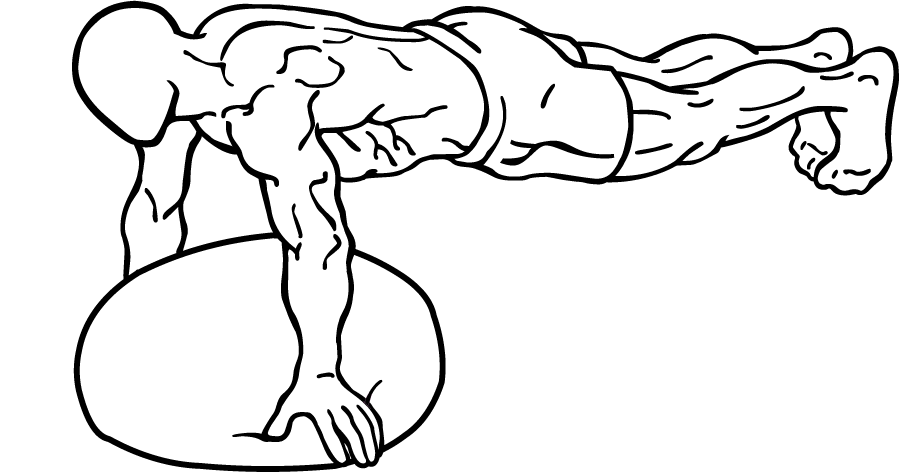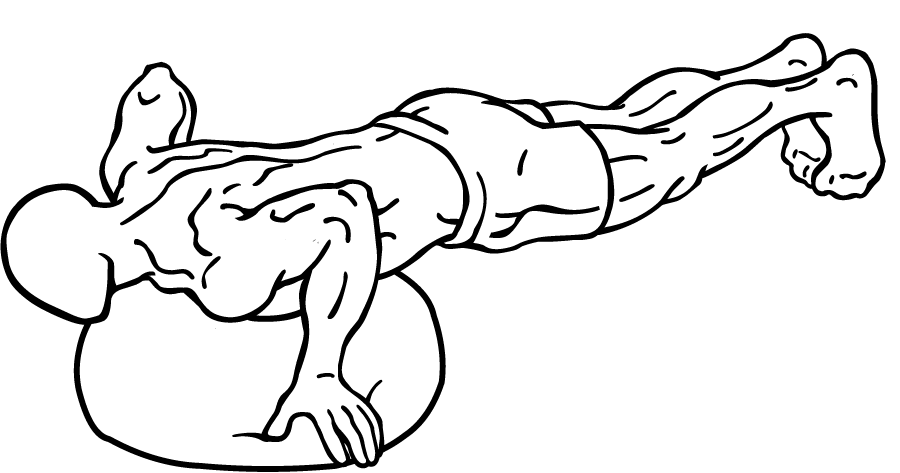Last Updated on September 30, 2014
If you’re looking for an effective way to strengthen your chest, core, shoulders, and triceps while adding a new challenge to your routine, the Bosu Ball Push Up is the perfect exercise to include in your workout regimen. This versatile exercise not only builds strength but also improves balance and stability, making it a great all-around functional movement. Whether you’re a beginner or a seasoned athlete, learning how to master this move can take your fitness level up a notch.
What is a Bosu Ball Push-Up?
A Bosu Ball Push-Up is a variation of the traditional push-up, but with the added twist of using a Bosu ball. A Bosu ball is a fitness tool that has a flat platform on one side and a dome-shaped, inflatable rubber ball on the other. This unique shape makes it ideal for balance and stability exercises, like the Bosu Ball Push-Up.
By incorporating the Bosu ball, this exercise forces your body to stabilize itself more effectively, engaging not just your chest and triceps but also your core, shoulders, and even your lower body. It’s a complete upper-body workout that activates various muscle groups simultaneously.
Benefits of Bosu Ball Push-Ups
Before we dive into the step-by-step instructions, let’s take a closer look at why Bosu Ball Push-Ups are worth incorporating into your workout routine:
- Improved Balance and Stability: The unstable surface of the Bosu ball challenges your balance, forcing your core and stabilizer muscles to work harder. This leads to improved coordination and stability in other exercises and daily activities.
- Increased Core Activation: Traditional push-ups already engage the core, but the Bosu ball takes it up a notch. The instability forces your core muscles to stay tight and activated throughout the entire movement, improving your overall core strength.
- Enhanced Upper Body Strength: While the Bosu Ball Push-Up primarily targets the chest and triceps, it also works your shoulders and engages your back muscles, giving you a well-rounded upper-body workout.
- Injury Prevention: Strengthening your stabilizer muscles reduces the risk of injury in other exercises and sports. The Bosu Ball Push-Up promotes joint stability, which is essential for preventing shoulder, elbow, and wrist injuries.
- Variety and Fun: Doing the same exercise routine can become monotonous. Adding Bosu Ball Push-Ups to your workout keeps things fresh and exciting, preventing workout fatigue while still being effective.
Muscles Worked During Bosu Ball Push-Ups
A key advantage of Bosu Ball Push-Ups is their ability to engage multiple muscle groups. Here’s a breakdown of the muscles you’ll be working:
- Chest (Pectoralis Major and Minor): The main muscles worked during push-ups, the chest muscles, are highly activated during the lowering and pressing phases of the exercise.
- Triceps (Triceps Brachii): The triceps play a critical role in extending your arms as you push yourself up from the Bosu ball.
- Shoulders (Deltoids): Your shoulders help stabilize the movement and assist in the pressing motion.
- Core (Rectus Abdominis, Obliques, and Transverse Abdominis): Maintaining a straight body throughout the movement requires significant engagement of your core muscles, which helps with balance and stability.
- Stabilizer Muscles: These include smaller muscles like the rotator cuffs and the muscles around your spine, which help you maintain control over the Bosu ball’s unstable surface.
How to Perform Bosu Ball Push-Ups Correctly
Now that you know why Bosu Ball Push-Ups are beneficial, let’s walk through how to do them step by step.
Step-by-Step Instructions:
- Get into Starting Position: Place the Bosu ball on the floor with the flat side facing down. Position your hands on the sides of the ball, slightly wider than shoulder-width apart. Your fingers should wrap around the edges of the ball to provide a firm grip. Keep your arms fully extended.
- Assume a Plank Position: Straighten your body into a plank position by extending your legs behind you. Keep your feet together, and ensure your body forms a straight line from your head to your heels. Your core should be tight, and your hips should not sag or rise too high.
- Lower Your Body: Slowly lower your chest towards the Bosu ball by bending your elbows. Keep your elbows close to your body throughout the movement. Aim to lower yourself until your chest is just above the ball, ensuring your core stays engaged, and your body remains in a straight line.
- Pause and Push Up: Hold the lowered position for a brief moment to maximize the muscle engagement. Then, push yourself back up to the starting position by straightening your arms. Remember to keep your core tight and your back flat.
- Repeat: Perform the exercise for the desired number of repetitions. For beginners, aim for 8-10 repetitions per set. As you get stronger, increase the number of reps or add more sets.
Tips for Proper Form:
- Keep Elbows Close: To maximize triceps activation and protect your shoulders, make sure to keep your elbows close to your sides as you lower your body.
- Engage Core: Avoid letting your lower back sag or your hips rise too high. Engaging your core is key to maintaining proper form and balance on the Bosu ball.
- Control the Movement: Avoid rushing through the exercise. Slow, controlled movements are more effective for building strength and improving stability.
Modifications for Beginners
The Bosu Ball Push-Up can be challenging, especially if you’re new to push-ups or stability exercises. Here are a few modifications to help you ease into the exercise:
- Knee Push-Ups: If a full push-up is too difficult, start by doing the push-up from your knees. This reduces the amount of body weight you have to push, making the exercise more manageable. Keep your feet off the ground and focus on maintaining a straight line from your knees to your shoulders.
- Incline Push-Ups: You can also perform an incline version of the Bosu Ball Push-Up by placing the Bosu ball against a wall or elevated surface. This reduces the angle at which you perform the push-up, making it easier to execute.
- Plank Hold: If you’re struggling with balance, start by holding a plank position with your hands on the Bosu ball. This will help you build core strength and stability before progressing to the full push-up.
- Partial Reps: If you’re not able to lower yourself all the way down, perform partial reps by lowering your chest only partway to the ball and then pushing back up.
As you build strength and confidence, gradually increase the intensity of the exercise by transitioning to the full Bosu Ball Push-Up.
Advanced Variations for Experienced Exercisers
Once you’ve mastered the basic Bosu Ball Push-Up, you can ramp up the challenge with these advanced variations:
- One-Legged Bosu Ball Push-Up: Lift one leg off the ground while performing the push-up. This adds an extra balance challenge and engages your core even more.
- Bosu Ball Push-Up to Mountain Climber: After completing a push-up, immediately perform a mountain climber by driving one knee towards your chest while balancing on the Bosu ball. Alternate legs with each repetition.
- Bosu Ball Push-Up with a Twist: Perform a push-up as usual, but as you push back up, rotate your torso and extend one arm towards the ceiling. Return to the starting position and repeat on the other side.
- Weighted Bosu Ball Push-Up: To further increase resistance, wear a weighted vest or place a weight plate on your back while performing the exercise. Be cautious with this variation, as it requires excellent form and stability.
Common Mistakes to Avoid
As with any exercise, proper form is crucial for maximizing the benefits and preventing injury. Here are some common mistakes to watch out for when performing Bosu Ball Push-Ups:
- Sagging Hips: Letting your hips sag indicates a weak core. Engage your abs throughout the entire movement to prevent this.
- Flared Elbows: Allowing your elbows to flare out wide puts unnecessary strain on your shoulders. Keep your elbows close to your body for proper alignment.
- Bouncing: Avoid bouncing or using momentum to push yourself up. Focus on controlled, deliberate movements to fully engage the muscles.
- Rushing Reps: Quality over quantity. Performing fewer reps with proper form is more effective than rushing through a high number of reps with poor form.
How to Incorporate Bosu Ball Push-Ups Into Your Workout
Bosu Ball Push-Ups are incredibly versatile and can be incorporated into your workout routine in various ways. Here are a few ideas:
- Upper Body Strength Workouts: Include Bosu Ball Push-Ups as part of your chest and triceps routine. Pair them with other upper-body exercises like dumbbell presses, triceps dips, and shoulder presses.
- Full-Body Circuits: Add Bosu Ball Push-Ups to a circuit-style workout that includes exercises like squats, lunges, and planks for a total-body conditioning session.
- Core Workouts: Since the Bosu Ball Push-Up heavily engages your core, it’s a great addition to any core-focused workout. Combine it with planks, Russian twists, and leg raises for a killer ab routine.
- HIIT Workouts: Include Bosu Ball Push-Ups in a high-intensity interval training (HIT) workout. Perform the Bosu Ball Push-Up as part of a HIIT circuit, alternating between push-ups, jumping jacks, burpees, and other high-intensity exercises. This will elevate your heart rate and provide both strength and cardiovascular benefits.
Sample Bosu Ball Push-Up Workout Routine
Here’s a simple routine to incorporate Bosu Ball Push-Ups into your workout. This can be adjusted depending on your fitness level, so feel free to modify it as needed:
Warm-Up:
- 5 minutes of light cardio (jump rope, jogging, or cycling)
- Dynamic stretches focusing on your chest, shoulders, and arms (arm circles, chest openers)
Bosu Ball Push-Up Circuit (repeat 3 times):
- Bosu Ball Push-Ups: 10-12 reps
- Bosu Ball Plank Hold: 30 seconds
- Bosu Ball Squats: 15 reps (stand on the flat side of the Bosu ball for added balance challenge)
- Bosu Ball Push-Up to Mountain Climber: 8-10 reps per leg
Rest: 60 seconds between each round
Cool Down:
- 5 minutes of stretching (focus on chest, shoulders, triceps, and core)
This routine provides a balanced mix of upper body, core, and lower body exercises that keep your muscles engaged while promoting balance and stability.
Frequently Asked Questions About Bosu Ball Push-Ups
1. Can I perform Bosu Ball Push-Ups every day? While Bosu Ball Push-Ups are an excellent exercise, like any resistance training, it’s essential to allow your muscles time to recover. Incorporate them into your workout 2-3 times per week, depending on your fitness goals and how your body feels.
2. How do I know if I’m using proper form? One way to check your form is by using a mirror or recording yourself while doing the push-up. Make sure your body remains in a straight line throughout the movement, and that your elbows stay close to your sides. If you feel discomfort in your lower back or shoulders, reassess your form and make adjustments.
3. Can Bosu Ball Push-Ups help with fat loss? Bosu Ball Push-Ups are a strength-training exercise that builds muscle. While they don’t directly burn as many calories as cardio exercises, they do help increase muscle mass, which can boost your metabolism over time. When combined with a calorie-controlled diet and regular cardio, they can contribute to fat loss.
4. Should I perform Bosu Ball Push-Ups on the flat or round side of the ball? For beginners, it’s generally recommended to perform the push-up with the flat side of the ball down, as this provides more stability. As you advance, you can try placing the flat side up, which will create more instability and increase the challenge for your core and upper body.
Add Bosu Ball Push-Ups to Elevate Your Workouts
Bosu Ball Push-Ups are a dynamic exercise that can help improve your upper body strength, core stability, and overall balance. Whether you’re a beginner or an experienced athlete, this exercise offers a range of benefits that can enhance your fitness routine. Start by mastering the basics, and then progress to more challenging variations as your strength and stability improve.
By adding Bosu Ball Push-Ups to your workout regimen, you’ll experience the benefits of a full-body workout that targets key muscle groups while improving your balance and coordination. Remember to focus on maintaining proper form, and don’t be afraid to adjust the exercise to suit your fitness level. Over time, you’ll see improvements in strength, endurance, and stability, helping you reach your fitness goals faster.
Ready to take your push-up game to the next level? Give Bosu Ball Push-Ups a try and enjoy the challenge of this exciting exercise!

















